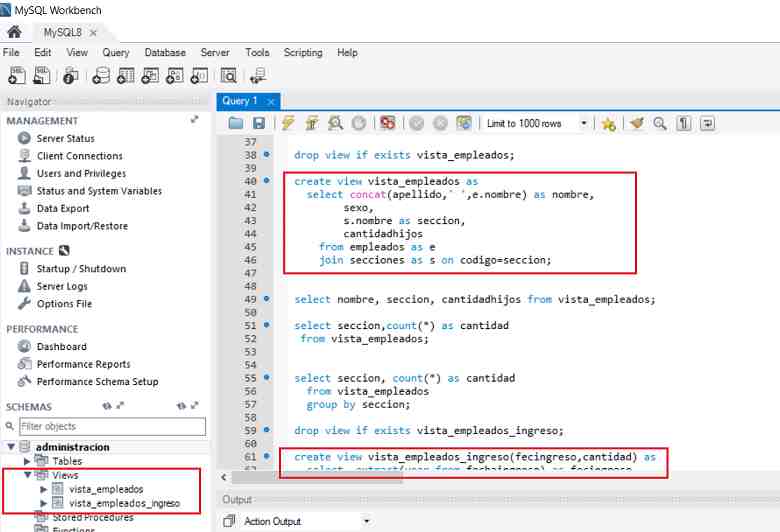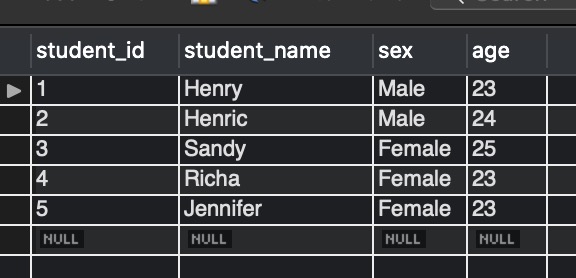

- MYSQL CREATE VIEW SPECIFY COLUMN TYPE HOW TO
- MYSQL CREATE VIEW SPECIFY COLUMN TYPE UPDATE
- MYSQL CREATE VIEW SPECIFY COLUMN TYPE CODE
- MYSQL CREATE VIEW SPECIFY COLUMN TYPE FREE
Create a Trigger CREATE TRIGGER trigger_name trigger_time trigger_event Deleting a View DROP VIEW View_name Triggers 1.
MYSQL CREATE VIEW SPECIFY COLUMN TYPE HOW TO
How to call view SELECT * FROM View_name 3. DROP INDEX DROP INDEX index_name ON table_name Views 1. CREATE INDEX CREATE INDEX index_name on table_name(column_name) ĬREATE UNIQUE INDEX index_name on table_name(column_name) 2. DELETE DELETE FROM table_name where condition Example DELETE from EMPLOYEE where empId='0001' Indexes 1.
MYSQL CREATE VIEW SPECIFY COLUMN TYPE UPDATE
WHERE condition Example UPDATE EMPLOYEE SET dept = 'Sales' WHERE empId='0001' 4. Example SELECT * FROM EMPLOYEE where dept ='sales' 3. Example INSERT INTO EMPLOYEE VALUES (0001, 'Ava', 'Sales') 2. INSERT INSERT INTO table_name (column1, column2, column3. COMMENT Single-Line Comments: -Line1 Multi-Line comments: /* Line1, RENAME RENAME TABLE table_name1 to new_table_name1 6. ALTER ALTER TABLE Table_name ADD column_name datatype Example INSERT INTO EMPLOYEE VALUES (0001, 'Dave', 'Sales') 3.

Supports many operating systems like Linux*,CentOS*, Solaris*,Ubuntu*,Windows*, MacOS*,FreeBSD* and others.High productivity as it uses stored procedures, triggers, views to write a highly productive code.Reliable, very fast and easy to use database server.

Open-source relational database management systems.
MYSQL CREATE VIEW SPECIFY COLUMN TYPE FREE
MySQL is a open-source, free and very popular relational database management system which is developed, distributed and supported by Oracle corporation.
MYSQL CREATE VIEW SPECIFY COLUMN TYPE CODE
The editor shows sample boilerplate code when you choose language as 'MySQL' and start writing queries to learn and test online without worrying about tedious process of installation. Getting started with the OneCompiler's MySQL editor is really simple and pretty fast. It's one of the robust, feature-rich online editor and compiler for MySQL. In this tutorial, you have learned about the MySQL JSON data type and how to use it for storing JSON documents in the database.Write, Run & Share MySQL queries online using OneCompiler's MySQL online editor and compiler for free. To calculate the total revenue by the visitor, you use the following query: SELECT visitor, SUM(properties-> '$.amount') revenueįROM events WHERE properties-> '$.amount' > 0 GROUP BY visitor The output of the query is as follows: + -+-+

To get the browser usage, you can use the following statement: SELECT browser-> '$.name' browser,įROM events GROUP BY browser-> '$.name' To remove the quote marks, you use the inline path operator ( ->) as follows: SELECT id, browser-> '$.name' browserĪs you can see in the following output, the quote marks were removed: + -+-+ Notice that data in the browser column is surrounded by quote marks. This query returns the following output: + -+-+ To pull values out of the JSON columns, you use the column path operator ( ->). Let’s insert some data into the events table: INSERT INTO events(event_name, visitor,properties, browser) They are used to store properties of an event and specification of the browser that visitors use to browse the website. The properties and browser columns are the JSON columns. An event also has a name e.g., pageview, purchase, etc., The visitor column is used to store the visitor information. CREATE TABLE events(Įach event in the events table has an id that uniquely identifies the event. To store this information, we will create a new table called events. Some visitors may just view the pages and other may view the pages and buy the products. Suppose, we have to track the visitors and their actions on our website. When you query data from the JSON column, the MySQL optimizer will look for compatible indexes on virtual columns that match JSON expressions. Instead, you can create an index on a generated column that contains values extracted from the JSON column. In addition, a JSON column cannot be indexed directly. Notice that a JSON column cannot have a default value. To define a column whose data type is JSON, you use the following syntax: CREATE TABLE table_name (Ĭode language: SQL (Structured Query Language) ( sql ) The storage of a JSON document is approximately the same as the storage of LONGBLOB or LONGTEXT data. The JSON binary format is structured in the way that permits the server to search for values within the JSON document directly by key or array index, which is very fast. MySQL stores JSON documents in an internal format that allows quick read access to document elements. The native JSON data type allows you to store JSON documents more efficiently than the JSON text format in the previous versions. MySQL supports the native JSON data type since version 5.7.8. Summary: in this tutorial, you will learn how to use MySQL JSON data type to store JSON documents in the database.


 0 kommentar(er)
0 kommentar(er)
